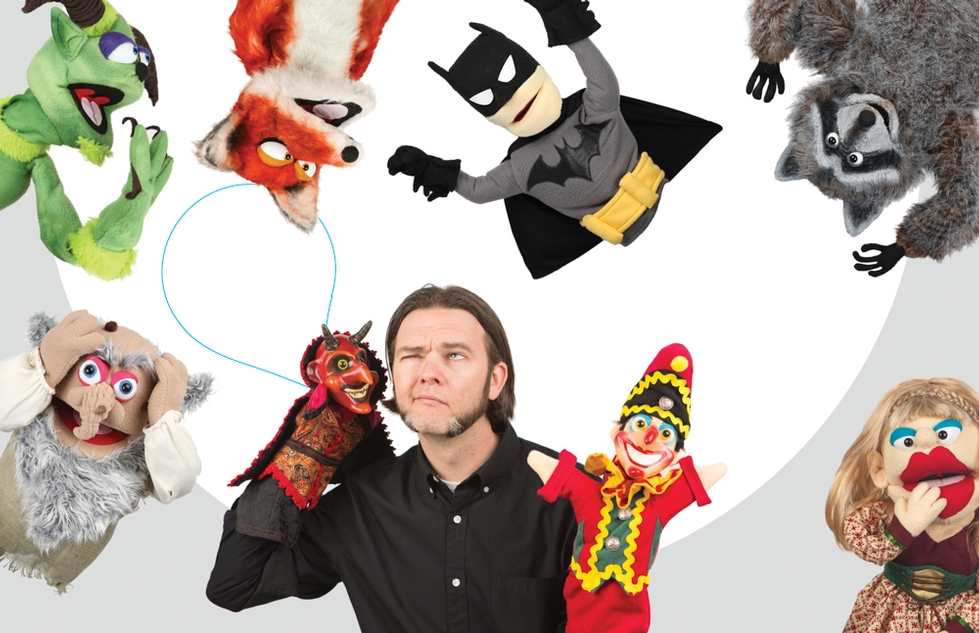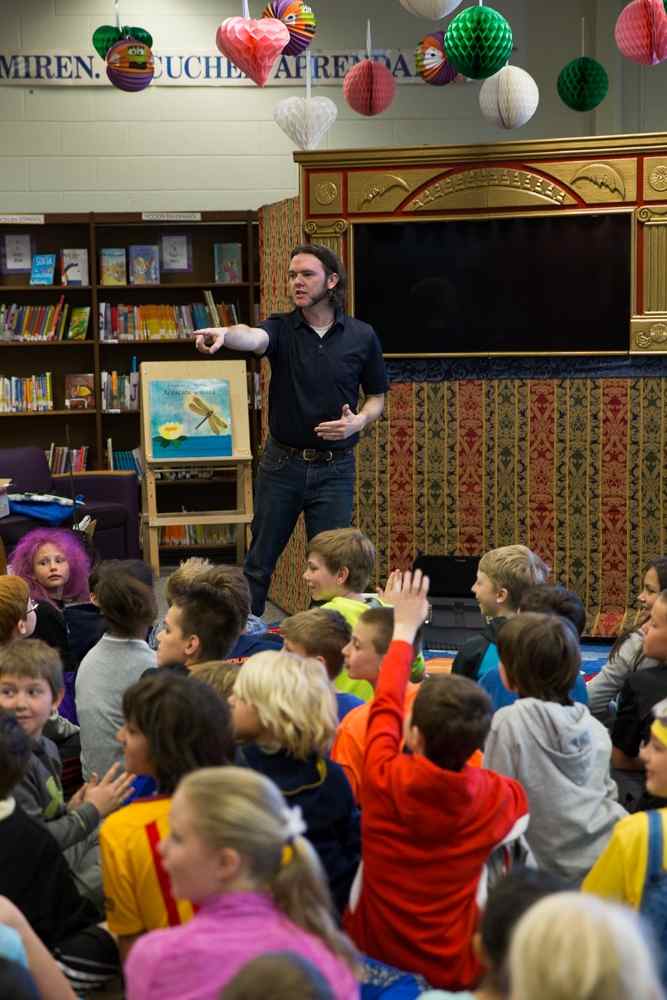Off the Path Summer 2016
Puppeteering professor
Spanish professor incorporates puppets into curriculum
by Matthew Makowski
photos by Elizabeth Lienau
Puppet characters from shows like “The Muppets,” “Sesame Street” and “Mister Rogers’ Neighborhood” have become pop culture icons in the worlds of television, film and theater.
At Grand Valley, puppets are teaching Spanish to college and area elementary school students. Well, the puppets themselves may not teach Spanish, but the man behind the puppets does.
Jason Yancey, associate professor of Spanish, brought his more than 15 years of puppeteering experience to Grand Valley in 2009. Since then, he has incorporated his unique expertise into upper-level Spanish theater and drama courses.
During these classes, students write and produce original Spanish puppet shows, and also create their own customized puppets. Students choose the style of puppet they create based on what is needed to tell the stories they write.
“Some stories work well with shadow puppets where there’s music and the story is more emotional, but in other stories puppets might need to be able to pick something up or talk, so they’ll need to build wide-mouth puppets, or Muppets, as they are commonly known,” Yancey said.
The scripts are eventually narrowed down to about 10, which students refine together in class before performing them at Spanish immersion elementary schools in West Michigan.

Jason Yancey is surrounded by his puppets.
“The presence of my Spanish-speaking university students in those classrooms validates the importance of understanding Spanish culture, learning Spanish and going to college,” Yancey said. “That message has nothing to do with puppets, but the puppets are a reason for us to be there.”
Yancey discovered his love for puppeteering while pursuing his bachelor’s degrees in theater and Spanish from Brigham Young University in Utah. He took a puppetry course in order to prepare for a stage adaptation of the children’s book Where the Wild Things Are, which he would eventually write and direct for another class.
The professor of Yancey’s puppetry class was so impressed by the puppets he created and how he worked with them that the duo performed together at festivals, children’s hospitals, holiday events and university events for the next six years while Yancey completed his master’s degree in Spanish.

Yancey presents a puppet show to students at Ada Vista Elementary School.
Since that time, Yancey has amassed a collection of more than 200 custom-made puppets, most of which were created for specific shows.
“I had a show about a pirate who caught different things from the ocean, like a clam and a whale, for example,” Yancey explained. “Once they outlive their shows, they go in my bag and become ‘stunt doubles,’ which are used by my students or kids during workshops.”
When students work with his “stunt doubles,” Yancey said they develop the confidence needed to speak in Spanish in front of an audience.
“You can’t see the students at all because they’re hiding behind a curtain and the puppets, so if there is a grammar or vocabulary mistake, it’s the puppet’s fault, not theirs,” Yancey said. “Because of that, students who are otherwise shy or timid really open up.”
Some of Yancey’s students have even capitalized on their distinctive experiences with puppeteering by adding it to their résumés.
“I’ll often get students who tell me they put ‘Spanish puppets’ on their resumes and they say people ask and get excited about the puppets,” Yancey said. “That unique conversation makes you different and stand out. Honestly, I’m here at Grand Valley, in part, because someone asked me those kinds of questions in my interview.”
Puppet styles
Wide-mouth (Muppet)
Glove
Rod
Japanese Bunraku
Shadow
Italian pupi
Finger
Body (Big Bird, Barney)
Armature
Ventriloquist dummies
Sock
While Yancey’s students appreciate his puppetry work, his biggest fans are his four kids who have seen all of his puppet shows.
“I film everything so I can watch the performances later, and my youngest son, who is almost 8, pops in a DVD of a puppet show just about every weekend,” Yancey said. “He’s always a little frustrated during the semesters that I’m teaching my class because I have the puppets in my office and not at home.”
Yancey has even called upon his children to perform with him, or to play with his puppets so he can see if they are operating as intended.
The only time Yancey’s kids don’t care for his puppets is when they are being created in the family’s basement.
“All of the pipes are exposed on the ceiling so it’s great because I can hang my puppets while I’m working on them, but my kids get creeped out when they go into the basement and see all of these ‘bodies’ hanging from the ceiling,” Yancey said.
After the final curtain falls, Yancey said he keeps returning to puppeteering because of the community connection.
“I feel like all of the work produced by myself and my students means something and changes the world, even if only for one kid,” Yancey said.
